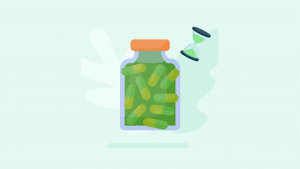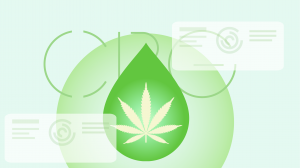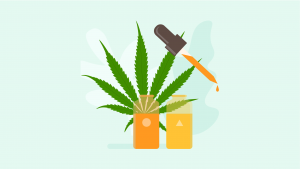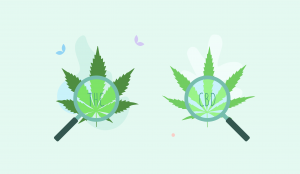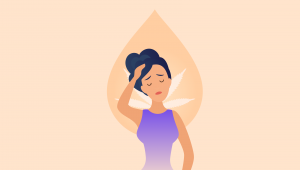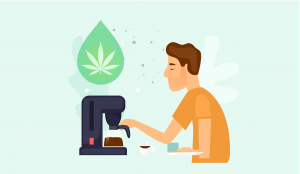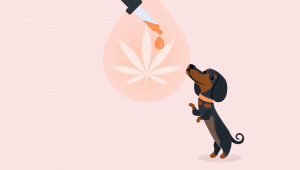
Evidence based
What is the Entourage Effect?
There are over 113 known cannabinoids and hundreds of other phytochemicals in the cannabis plant — all working together through a phenomenon known as the entourage effect.
Here’s how it works.
The entourage effect is a phenomenon where the effects of a hemp extract are strongest when all the individual constituents are kept together.
When single elements are isolated — the effects become weaker.
When single elements are supported by other elements — the effects become stronger.
All 113 cannabinoids, several hundred different terpenes, lignans, flavonoids, polyphenols, and numerous other trace chemicals found within the cannabis plant all act together as an entourage to produce a greater impact on the body.
Here’s how it works.

How to Maximize the Entourage Effect:
The bottom line here, is how can you get more entourage effect? How can we get as much out of our CBD products as possible?
The simple answer is to seek products that offer greater diversity in the phytochemical makeup as possible — like hemp flower, CBD live resin extracts, CBD pastes & waxes, and full-spectrum CBD oils.
The level of processing of the hemp extract has a direct impact on the level of entourage effect within each product.
On the opposite side of the spectrum, we have concentrates like CBD crystals, CBG crystals, CBD isolate oils, and most CBD gummies.
The Entourage Effect = Plant Synergy
Synergy is the idea that certain compounds, when taken together, will produce effects greater in combination than the sum of their parts [4].
Here’s an example:
St. John’s Wort is a herb best known for its antidepressant effects because of a compound called hypericin. However, when isolated, hypericin offers no benefits and actually makes symptoms worse.
Scientists tested the entire plant extract containing everything except hypericin as a control to see if this works the other way — the results showed no antidepressant benefit.
Researchers concluded that hypericin is the active ingredient for the antidepressant activity of St. John’s Wort, but relies on all the other constituents to do its job effectively. The plant essentially needs all of its compounds to produce any measurable benefits.
Cannabis works similarly, and we’re starting to find discrepancies between the uses of CBD in full-spectrum extracts compared to CBD isolates (extracts made without the rest of the entourage).
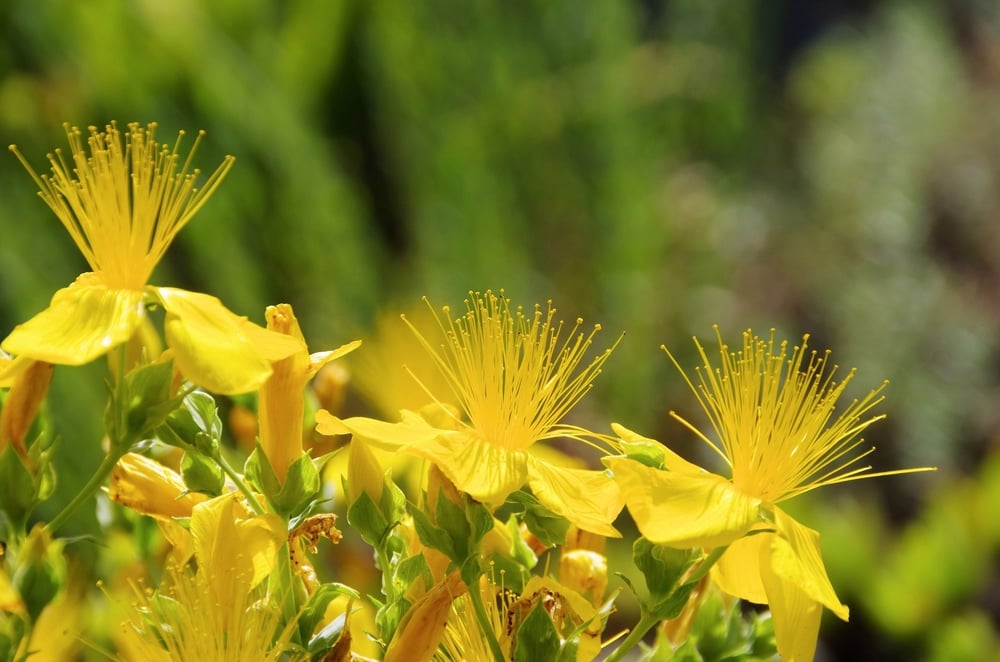
The Nitty Gritty: How Synergy Actually Works (Mechanisms)
There are many ways compounds can work together to produce their effects:
- Increasing bioavailability (absorption of the compounds through the gastrointestinal tract)
- Interfering with cellular transport processes (such as improving passage through the blood-brain barrier)
- Activation of pro-drugs (non-active compounds that convert to active ones in the liver)
- Slowing the deactivation of active compounds to inactive metabolites
- Providing similar benefits through separate mechanisms
- Inhibiting the binding of compounds to cell receptors (blocking the effects of other compounds)
- Enhancing the binding of compounds to cell receptors (increasing the effects of compounds)
The Cannabinoids
Cannabinoids are the primary active constituents of the cannabis plant, they act like the leaders of the entourage.
Powerhouses like THC and CBD carry much of the weight of the plants’ therapeutic effects.
Other cannabinoids like CBC, CBG, or CBN offer their own set of benefits and interact with these powerhouses to either improve absorption, reduce negative side-effects, or otherwise improve effects on the body.
A) THC (Delta 9 Tetrahydrocannabinol)
Delta 9 THC is the primary psychoactive ingredient in the cannabis plant. It works by activating the CB1 and CB2 receptors of the endocannabinoid system. Triggering the CB1 receptors in the central nervous system causes a change in serotonin levels, which gives this compound its psychoactive side effects.
Most hemp oils only contain THC only in small amounts (less than 0.3%). Marijuana strains, however, can contain up to 30% THC by weight.
There are other forms of THC that can be used synergistically with CBD as well — such as delta 8 THC (for relaxation), delta 10 THC (for stimulation), THCC (for nerve pain), and THCP (for powerful psychoactive effects).
Synthetic forms of THC exist as well (such as THC-O and HHC)and are common in the market today. Despite being synthetic, anecdotal reports show clear signs these cannabinoids are still synergistic when used in combination with CBD, other cannabinoids, and cannabis-derived terpenes.
The Effects of THC:
- Appetite stimulant
- Sedative (low doses)
- Stimulant (high doses)
- Psychoactive
B) THCV (Tetrahydrocannabivarin)
THCV (tetrahydrocannabivarin) is significantly weaker in its effects when compared to THC. Some research suggests that THCV is only 20-25% as strong in its psychoactive effects compared to THC [2].
Effects of THCV
- Appetite-suppressant
- Euphoric
- Antispasmodic
- Paranoic (induces paranoia)
C) CBD (Cannabidiol)
CBD (cannabidiol) is the primary medicinal compound of the cannabis plant. It works much differently to THC.
While THC stimulates the endocannabinoid receptors, CBD has minor interactions with them. Instead, CBD activates different receptors such as the opioid pain receptors, vanilloid receptors, and competitively inhibits the breakdown of our endocannabinoids like anandamide and 2-AG.
CBD is much better at improving our ability to maintain homeostasis (balance) compared to THC or most other cannabinoids. This ability to regulate homeostasis gives it a long list of benefits on the human body — ranging from inflammation and pain inhibition to hormone regulation and stress reduction.
Effects of CBD
- Anti Inflammatory
- Mild appetite suppressant
- Lowers stress
- Mild sedative
- Antiemetic (prevents vomiting)
- Reduces the side effects of THC
Related: 10 Strongest CBD Oils You Can Buy in 2021.
D) CBC (cannabichromene)
In most cases, CBC (cannabichromene) is the third most abundant cannabinoid, though there are exceptions to this.
This compound is non-psychoactive and offers excellent anti-anxiety and antidepressant activity, especially in combination with CBD.
Unfortunately, there are few studies to quantify the effects of this cannabinoid, though we can expect to see a lot more information released on this cannabinoid in the near future.
Effects of CBC
- Antidepressant
- Mild sedative
- Anti-anxiety
E) CBG (Cannabigerol)
CBG stands for cannabigerol, it’s one of the precursors for other cannabinoids like THC. It inhibits many effects of THC by producing an opposite effect — blocking the activation of serotonin to reduce the psychoactive side effects.
CBG is one of the strongest anti-anxiety cannabinoids found in the cannabis plant.
Effects of CBG
- Anti-anxiety
- Adaptogenic (stress reduction)
- Mild sedative
- Inhibits some of the effects of THC
Suggested Reading: Best CBG Concentrates For 2021.
F) CBN (Cannabinol)
CBN (cannabinol) is a byproduct of THC. This means that as THC breaks down, some of it is converted to CBN. This cannabinoid is mostly non-psychoactive but will produce some mild psychoactive side effects in some individuals.
CBN is more sedative than most other cannabinoids and therefore is excellent for people using cannabis for conditions like insomnia, anxiety, or high stress.
Effects of CBN
- Sedative
- Anti-anxiety
- Appetite stimulant

The Terpenes
Terpenes are small aromatic compounds (they evaporate in low temperatures and have an aroma).
If you’ve ever used marijuana or a high-quality hemp extract, you’ve most likely experienced the aroma of the cannabis plant. The fragrance can vary significantly from one strain of cannabis to the next — mostly due to the different terpenes in cannabis.
Some of the terpenes in cannabis are shared in other, unrelated species — such as limonene from citrus fruits, myrcene from nutmeg, or pinene from the pine tree. The shared terpenes are what give hemp and marijuana plants their aromas.
These terpenes contribute heavily to the entourage effect of the plant despite making up only 1% of the cannabis plant by weight [3].
Some terpenes improve the absorption of the cannabinoids from the digestive tract and lungs — producing stronger effects. Others slow the metabolism of cannabinoids in the liver, and others will provide therapeutic effects on depression, anxiety, pain, or muscle tension — further adding to the overall effect of the plant.

List of Common Cannabis Terpenes
- A-humulene — a powerful antibacterial
- Alpha Bisabolol —anti-inflammatory
- Alpha-Terpineol — sedative, antioxidant, and memory enhancer
- Beta-Pinene — memory enhancer, neuroprotective, and anti-inflammatory
- Beta-Caryophyllene —anti-anxiety, antidepressant, sedative
- Bisabolol — anti-inflammatory
- Borneol — sedative, muscle relaxant, neuroprotective
- D-Linalool — muscle relaxant, pain-reliever, anti-anxiety
- Geraniol — powerful antioxidant
- Limonene — anti-anxiety, antidepressant, enhances cannabinoid receptor binding
- Myrcene — analgesic, sedative, improves cannabinoid absorption
Other Phytochemicals
There are hundreds of compounds in the cannabis plant, many of which have therapeutic benefit on their own. There are far too many to list here, and most remain poorly understood by science.
Many phytochemicals in cannabis are active constituents of other medicinal plants, but some are unique to the cannabis genus.
It’s debatable what role each of these phytochemicals plays in the overall effects of hemp and marijuana plants. However, it’s well-understood that they’re an important contributing factor to the overall entourage effect of the plant.
The Top Five Non-Cannabinoid and Non-Terpene Compounds in Cannabis:
- Benzoic acid — antibacterial agent not common in the plant kingdom
- Hydroxycinnamic acid — anti-inflammatory ingredient also found in cinnamon
- Apigenin — a potent anti-anxiety and estrogenic compound found abundantly in chamomile
- Lignanamides — anti-inflammatory and anti-cancer compounds mainly found in hemp
- Stilbenes — potent antioxidants also found in other plants like blueberries
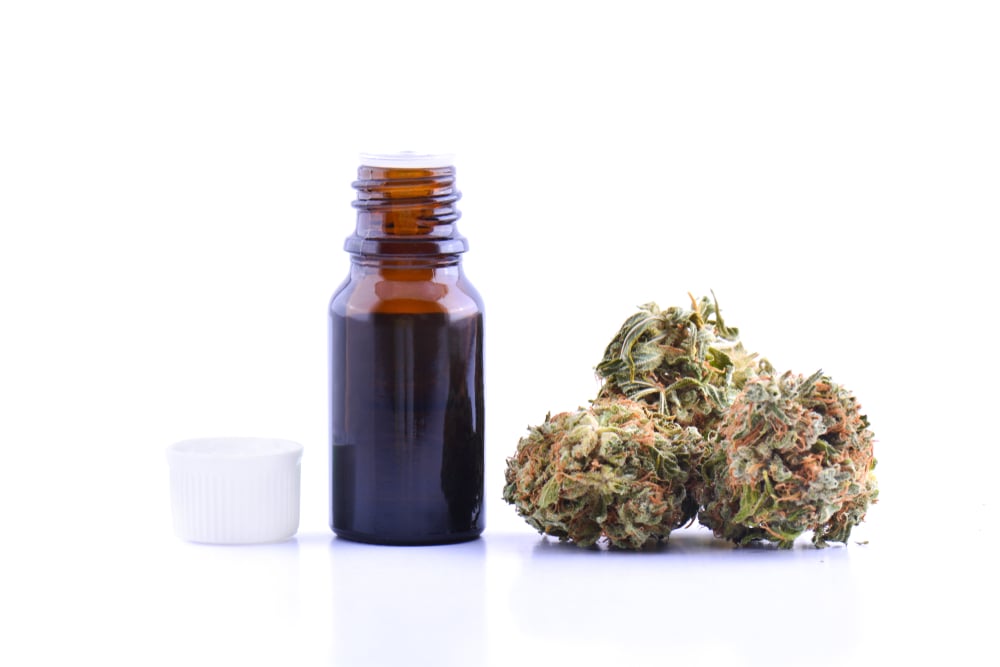
Full-Spectrum Hemp Oils vs. Isolates
When discussing the entourage effect, we need to consider two forms of hemp extracts — full-spectrum hemp oils and CBD isolates.
The distinction is essential because full-spectrum oils are the only products that leverage the entourage effect. The collection of multiple cannabinoids, terpenes, and other phytochemicals in the final product offer broader and more powerful benefits to the body.
Isolates, on the other hand, are purely CBD — there’s no entourage effect from these products.
Some companies try to add these compounds in after the purification, which does bring some benefits but won’t provide the same level of intricacy as full-spectrum oil in terms of synergy.
CBD & THC
In the early days of cannabis research, in the 1960s, researchers identified the primary psychoactive effects produced by the plant were the result of tetrahydrocannabinol (THC). The studies discovered other cannabinoids, but most efforts were dedicated to unlocking the secrets of THC.
It was later discovered that THC produces psychoactive effects in its isolated form but whole plant extracts caused fewer side effects and had much stronger overall benefits.
Purified, synthetic THC compounds were shown to produce unpredictable, often dangerous side effects.
The synergy in the cannabis plant began to develop when researchers investigated the role CBD played in cannabis’ medicinal benefits.
In 2006, research showed that adding CBD to a dose of THC significantly reduced the negative side effects of THC [1].
Although there are several theories as to why this happens, the prominent theory is that CBD has a protective effect on THC, slowing its breakdown and offering opposing effects on things like anxiety and mental stimulation. This offsets some negative side effects of THC and improves many of its benefits.
Other cannabinoids have demonstrated similar effects as well — including CBC, CBG, and CBN to name a few.
Most people refer to these positive interactions of cannabis compounds as the entourage effect. However, this concept is already well-established in the world of herbal medicine.
Key Takeaways: What is the Entourage Effect?
The entourage effect is a phenomenon where the effects of a hemp extract are strongest when all the individual constituents are kept together. When single elements are isolated the effects become weaker.
This effect is another word for plant synergy — which is a concept present in traditional herbal medicine for centuries.
To maximize the impact of the entourage effect, look for products that contain a full-spectrum extract. The more raw the extract, the stronger the effect.
Consider the many benefits of the entire spectrum of cannabinoids. Each cannabinoid has unique properties that provide medicinal benefits to the human body and work best together.
Sources Cited in This Article
- Russo, E., & Guy, G. W. (2006). A tale of two cannabinoids: the therapeutic rationale for combining tetrahydrocannabinol and cannabidiol. Medical Hypotheses, 66(2), 234-246.
- Hollister, L. E. (1974). Structure-activity relationships in man of cannabis constituents, and homologs and metabolites of Δ9-tetrahydrocannabinol. Pharmacology, 11(1), 3-11.
- Potter, D. (2009). The propagation, characterization and optimisation of cannabis sativa L as a phytopharmaceutical (Doctoral dissertation, King’s College London).
- Andre, C. M., Hausman, J. F., & Guerriero, G. (2016). Cannabis sativa: the plant of the thousand and one molecules. Frontiers in plant science, 7, 19.


